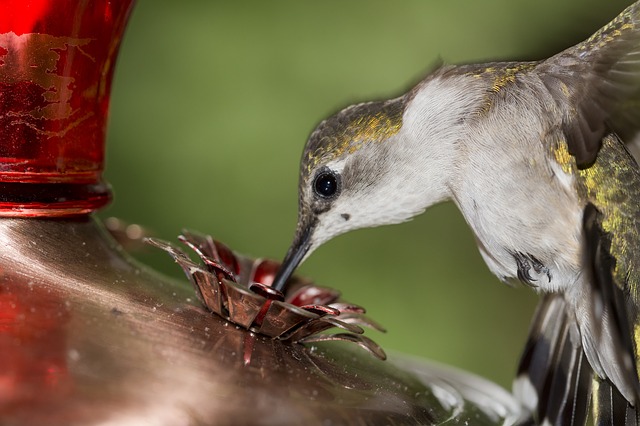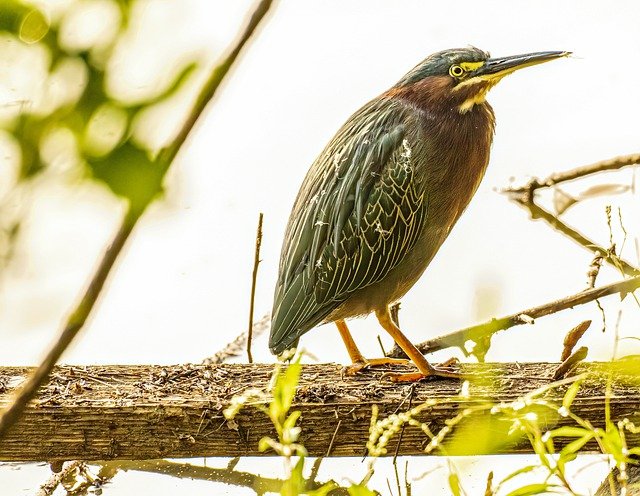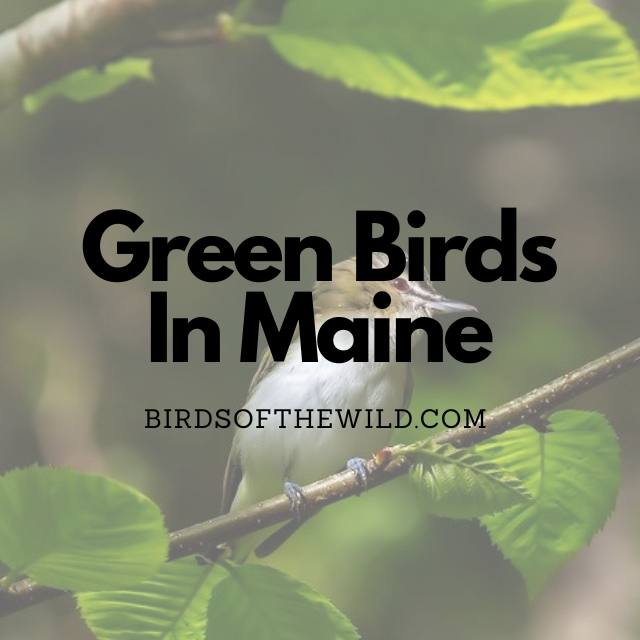In this article I’ll be going over 5 distinct avian lifeforms that can be found across the state of Maine so, continue reading for a more detailed look at each bird below.
- Red Eyed Vireo
- Ruby Throated Hummingbird
- Green Heron
- Mallard
- Ruby Crowned Kinglet
5 Green Birds In Maine
1. Red Eyed Vireo (Vireo Olivaceus)

- Size: 11 – 13cm
- Weight: 20 – 24 grams
- Wingspan: 23 – 25cm
Red eyed vireos are spring and summer residents all throughout Maine, which also would be the months that they tend to breed.
These vireos are recognised by there green feathers from the head, wings and back, white feathers on their breast and the stand out red eye. The females look very similar to the males.
As for where you’ll often see these birds perching or flying around, it would include environments with large expanses of deciduous forest, particularly deciduous trees with large leaves, like maple trees for example.
Red eyed vireos tend to eat mostly insects like caterpillars, moths, beetles, wasps, bees, ants, bugs, flies, as well as the occasional fruit and berry.
Red eyed vireos tend to live for around 6 – 7 years, whilst the oldest recorded one died at 10 years and 2 months.
2. Ruby Throated Hummingbird (Archilochus Colubris)

- Size: 7 – 9cm
- Weight: 2 – 6 grams
- Wingspan: 8 – 11cm
Ruby throated hummingbirds are spring and summer residents within Maine, which is also when these hovering birds tend to breed.
A ruby throated hummingbird can be recognised by their plumage that is red, white and green. Their throat is the red part, its breast/stomach white in color and their wings and back an emerald green color. Females are mostly white and green in color.
As for what they eat, it ranges from small insects, fruits, sugar water from feeders, tree sap and of course the nectar produced by blooming flowers.
Ruby throated hummingbirds tend to stay near environments with flowerbeds as these birds have a very strong metabolism that requires them to feed multiple times per hour. Therefore, you can find them in fields, parks, backyards, and open clearings in forests.
As for how long these tiny little hummingbirds can live for, it’s known to be around 3 – 5 years on average with the longest recorded lifespan just short of 7 years.
3. Green Heron (Butorides Virescens)

- Size: 40 – 44cm
- Weight: 230 – 250 grams
- Wingspan: 54 – 58cm
You’ll find green herons in all of Maine in their spring and summer breeding seasons.
These heron’s are recognised by their darker green back and wings, maroon chest and neck, with yellow legs and a relatively long and pointy black beak. Females on the other hand are mostly brown and gray in color.
Green herons tend to spend the majority of their time around wetlands like lakes, ponds, marshes, swamps, streamsides and rivers.
As for what they consume, it includes a variety of different sources such as small fish like minnows, sunfishes, gizzard shads, crustaceans, aquatic insects, frogs, tadpoles, grasshoppers, snakes, earthworms, snails and other smaller rodents.
Green herons don’t have the longest of lifespans for a bird of their size, with the maximum known life expectancy said to be around 8 years.
4. Mallard (Anas Platyrhynchos)

- Size: 50 – 65cm
- Weight: 0.72 – 1.6kg
- Wingspan: 81 – 98cm
Mallards can be spotted in southwest Maine all year round and in the remainder of the state all throughout their breeding season, specifically around ponds and lakes.
You’ll be able to recognise mallards by their dark, iridescent green head, brown neck, brown stripes upon the upper level of the wing with the remainder of their body a cream/white color. Females on the other hand are a mostly light brown patterned color with both male and females having orange webbed feets.
Mallards prefer calm, shallow sanctuaries, but can be found in almost any body of freshwater, which can include wetlands, saltwater and brackish water.
These ducks tend mostly to consume seeds, acorns and berries, plants, insects and shellfish.
In regards to lifespan, these mallards are known to live for around 5 – 10 years in the wild.
5. Ruby Crowned Kinglet (Regulus Calendula)

- Size: 9 – 11cm
- Weight: 5 – 10 grams
- Wingspan: 16 – 18cm
Ruby crowned kinglets can be found all throughout Maine when they breed.
These kinglets are recognised by their gray and green plumage throughout, besides the red/orange color on the top of their head. Females look almost the same bar the orange/red element on the head.
Ruby crowned kinglets will often be found by tall, dense conifer forests such as spruce, fir, and tamarack.
These kinglets eat the same food sources as most other birds in the wild, which in this case would be small insects, small berries, seeds and other smaller fruits.
As for how long a ring crowned kinglet can live for, it’s estimated to be around 4 – 6 years.
Amhil Khan, a dedicated nature enthusiast and the founder of BirdsOfTheWild.com, is a passionate advocate for the captivating world of avian wonders. With a deep-seated curiosity about the intricate lives of birds, Amhil’s journey began as a fascination and has evolved into a mission to inspire others to appreciate and protect these magnificent creatures.
Amhil’s love for birds led to the creation of Birds of the Wild, a platform where his expertise in ornithology, coupled with his captivating storytelling, provides readers with an immersive and educational experience. Through his lens and words, he captures the essence of birds in their natural habitats, offering a glimpse into their behaviors, migrations, and the ecosystems they inhabit.

